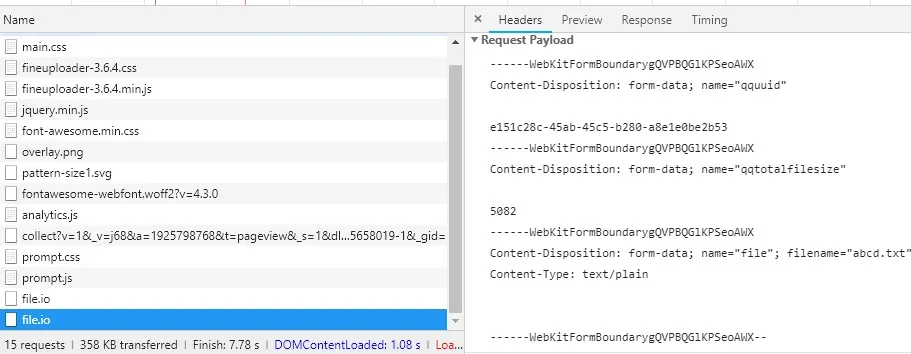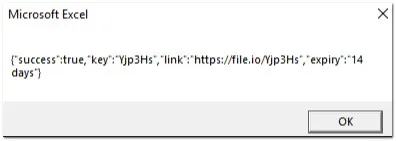使用XmlHttp VBA发布multipart/form-data的步骤
- 使用Chrome/Firefox/Fiddler观察HTTP请求。
- 首先手动上传文件,并查看浏览器发送的所有请求和响应(特别是具有状态码200的xhr,文档请求)。
- 将cookie、参数传递到POST请求中。
在这种情况下,我使用了Chrome浏览器,下面的图片显示了浏览器在请求中发送的参数。

Sub UploadFilesUsingVBA()
'this proc will upload below files to https://file.io/
' png, jpg, txt
Dim fileFullPath As String
fileFullPath = "C:\Users\santosh\Desktop\abcd.txt"
POST_multipart_form_data fileFullPath
End Sub
文件上传成功后的确认信息

Private Function GetGUID() As String
' Generate uuid version 4 using VBA
GetGUID = WorksheetFunction.Concat(WorksheetFunction.Dec2Hex(WorksheetFunction.RandBetween(0, 4294967295#), 8), "-", WorksheetFunction.Dec2Hex(WorksheetFunction.RandBetween(0, 65535), 4), "-", WorksheetFunction.Dec2Hex(WorksheetFunction.RandBetween(16384, 20479), 4), "-", WorksheetFunction.Dec2Hex(WorksheetFunction.RandBetween(32768, 49151), 4), "-", WorksheetFunction.Dec2Hex(WorksheetFunction.RandBetween(0, 65535), 4), WorksheetFunction.Dec2Hex(WorksheetFunction.RandBetween(0, 4294967295#), 8))
End Function
Private Function GetFileSize(fileFullPath As String) As Long
Dim lngFSize As Long, lngDSize As Long
Dim oFO As Object, OFS As Object
lngFSize = 0
Set OFS = CreateObject("Scripting.FileSystemObject")
If OFS.FileExists(fileFullPath) Then
Set oFO = OFS.getFile(fileFullPath)
GetFileSize = oFO.Size
Else
GetFileSize = 0
End If
Set oFO = Nothing
Set OFS = Nothing
End Function
Private Function ReadBinary(strFilePath As String)
Dim ado As Object, bytFile
Set ado = CreateObject("ADODB.Stream")
ado.Type = 1
ado.Open
ado.LoadFromFile strFilePath
bytFile = ado.Read
ado.Close
ReadBinary = bytFile
Set ado = Nothing
End Function
Private Function toArray(str)
Dim ado As Object
Set ado = CreateObject("ADODB.Stream")
ado.Type = 2
ado.Charset = "_autodetect"
ado.Open
ado.WriteText (str)
ado.Position = 0
ado.Type = 1
toArray = ado.Read()
Set ado = Nothing
End Function
Sub POST_multipart_form_data(filePath As String)
Dim oFields As Object, ado As Object
Dim sBoundary As String, sPayLoad As String, GUID As String
Dim fileType As String, fileExtn As String, fileName As String
Dim sName As Variant
fileName = Right(filePath, Len(filePath) - InStrRev(filePath, "\"))
fileExtn = Right(filePath, Len(fileName) - InStrRev(fileName, "."))
Select Case fileExtn
Case "png"
fileType = "image/png"
Case "jpg"
fileType = "image/jpeg"
Case "txt"
fileType = "text/plain"
End Select
Set oFields = CreateObject("Scripting.Dictionary")
With oFields
.Add "qquuid", GetGUID
.Add "qqtotalfilesize", GetFileSize(filePath)
End With
sBoundary = String(27, "-") & "7e234f1f1d0654"
sPayLoad = ""
For Each sName In oFields
sPayLoad = sPayLoad & "--" & sBoundary & vbCrLf
sPayLoad = sPayLoad & "Content-Disposition: form-data; name=""" & sName & """" & vbCrLf & vbCrLf
sPayLoad = sPayLoad & oFields(sName) & vbCrLf
Next
sPayLoad = sPayLoad & "--" & sBoundary & vbCrLf
sPayLoad = sPayLoad & "Content-Disposition: form-data; name=""file""; " & "filename=""" & fileName & """" & vbCrLf
sPayLoad = sPayLoad & "Content-Type: " & fileType & vbCrLf & vbCrLf & vbCrLf & vbCrLf & vbCrLf
sPayLoad = sPayLoad & "--" & sBoundary & "--"
Set ado = CreateObject("ADODB.Stream")
ado.Type = 1
ado.Open
ado.Write toArray(sPayLoad)
ado.Write ReadBinary(filePath)
ado.Position = 0
With CreateObject("MSXML2.ServerXMLHTTP")
.Open "POST", "https://file.io", False
.SetRequestHeader "Content-Type", "multipart/form-data; boundary=" & sBoundary
.Send (ado.Read())
MsgBox .responseText
End With
End Sub
帮助回答这个问题的链接
1. https://dev59.com/TqDia4cB1Zd3GeqPEn88#43266809
2. https://wqweto.wordpress.com/

